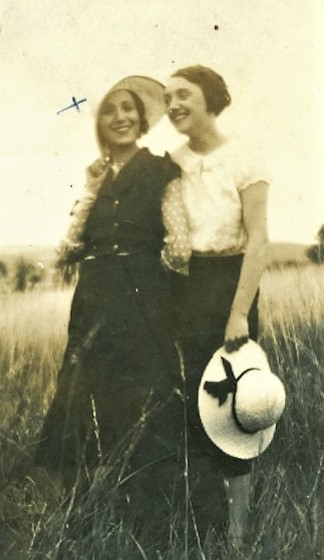The infamous backdrop of the Second World War has numerous nerve-wracking, influential incidents but there’s only one of them that inspired the invention of one of the most iconic perfumes of the world that continues to amaze the sensation of smell around the globe.
In the World of fashion, Christian Dior is a name enlisted amongst the elites. Known for his artistic vision that revolutionized women fashion post the Second World War era. There’s hardly anybody who’s not familiar with Christian Dior’s fashion house but very few know that behind this successful brand, there’s a hidden tale of a lady whose courage and sacrifice is unparalleled in history.
When asked about Christian Dior’s work, Gabrielle “Coco” Chanel, who was the predecessor of Dior in women’s fashion industry and one of the leading fashion critics, was quoted, “Dior doesn’t dress women, he upholsters them.”[1] However, Coco too was unaware about the woman who was the source of inspiration behind Dior’s creations. In order to commemorate the inspirational woman behind his work, in 1947, he debuted into the world of fragrances with one of the most iconic perfumes ever created, “Miss Dior”. As far as the folklore goes, the name came accidentally but as one gets to know more about Miss Catherine Dior, the name would hardly seem accidental.
Born on 2nd August 1917, Ginette Dior (who later changed her name to Catherine), was the younger sister of Christian Dior and the youngest family member in the Dior household at Callian, near Grasse in Provence. Although Catherine had 4 siblings, she was closest to Christian and was tremendously affectionate towards him. So much so that it is rumored that Christian Dior’s favorite day of the year was St Catherine’s Day and that’s what made Ginette change her name to Catherine.
Shakespeare once wrote –
“What’s in a name? that which we call a rose
By any other name would smell as sweet.”[2]
This however cannot be said in case of Catherine Dior. She took the name from St Catherine of Alexandria, who once counselled Joan of Arc, and as far as the comparison goes, Catherine was not far behind in terms of the strength of character.
During the month of November in 1941, the 24 years old Catherine was out to buy a good radio at Cannes’ market. As she was scrolling through different shops, she accidentally bumped into Hervé des Charbonneries, one of the founding members of the “French Resistance”, the Polish intelligence unit based in France. It was love at first sight for her. Hervé, who was 36 at that time and already a father of 3 children, quickly realized that Catherine was no ordinary girl. She had a strong personality and there was a strange stubbornness about her that could be channelized to achieve great things. He influenced her heavily and made her realize the importance of the intelligence unit during the war and thus a month later, Catherine became an official member of the French Resistance.

Catherine was put in charge of the “Massif Central” section of the F2 network, a British-funded Resistance intelligence unit which was originally set up by the Polish government-in-exile to operate in France. Her primary responsibility was to transmit covert information regarding German movements and artillery to British government in London. She was very much on top of her job and in order to expand her network, she used to chair secret meetings at Christian’s apartment in Paris. However, she never involved her dear brother or any of her family members into her business as their safety was also of paramount importance to her, not to mention the image of Christian Dior who was already a revered fashion designer by the time and having already received multiple threats from the Nazis to shut down his business altogether.
Her stint in the intelligence agency came to an end on 6th July 1944 when she was arrested by Gestapo along with her 26 fellow comrades. Catherine was in Gestapo’s radar for a long time as her network was considered to be the most dynamic in the entire Europe. As a result of that she was interrogated and tortured repeatedly by the notorious security-service unit. Despite their best efforts, the Gestapo officers failed to extract any information from her. Back in Paris, Christian was trying his best to arrange her release with the help of the Nazi contacts he had made during his business tours. When that didn’t work, he reached out for help towards his good friend Raoul Nordling, the Swedish consul-general. Nordling pulled some strings amongst his contacts inside the Nazi offices and somehow managed to persuade them to place Catherine under the supervision of the Swedish state. But it was too little too late for her as by the time the letter had reached its intended recipient, she was already deported along with 1,654 men and 542 women on a prison train leaving Paris towards the women concentration camp at Ravensbrück, 50 miles north of Belin under the supervision of SS leader Heinrich Himmler, one of the main architects of the Holocaust.
From there, it was a one-way road to suffering for Catherine. She along with her fellow comrades were identified as political prisoners hence their verdict would be extermination through work which in simple terms meant slave labour. It was the start of her abhorrent suffering; she was stripped of her clothes, given grimy rags to wear, beaten regularly throughout her working hours and was not allowed to sleep. Soon she was transferred to the military prison of Torgau and posted to the all-female “Anton Kommando” to work on the production of explosives in a disused potassium mine. The Nazis denied all her human dignities and yet they failed to break her stubbornness. Going above and beyond all her debility, she tried to disrupt the weapon manufacturing; first at Torgau then at Abberode, a satellite camp inside one of Buchenwald concentration camps. As the winter came closer, Catherine’s head was shaved, and she was severely beaten after being stripped of her remaining clothes and then transferred to an aviation factory at Leipzig-Markkleeberg in a train. The journey from Abberode to Leipzig took several days and during this time she was inside a freezing cattle truck without any supply of food or water. Catherine was suffering from pneumonia, dysentery, tuberculosis, and malnutrition. As she reached the factory in Leipzig, the exhausting workload made her increasingly weak.
Just when it seemed that death would be a mercy, she took one last leap of faith. On 13th April 1945, all the prisoners were assembled and asked to leave the camp. The journey was later referred to as “The Death March”[3]. Everyone was ordered to keep walking barefoot in freezing temperatures, without any food or water, under the supervision of SS officers who would shoot to kill anyone who would attempt to flee. Catherine did though. She managed to slip away as the march reached the destroyed city of Dresden. She stayed hidden amidst the chaos and ruins for several days, waiting for a miracle to happen.
Back in Paris, Christian had no clue about his dear sister’s whereabouts. He made several desperate attempts to extract any information whatsoever about her sister, which included seeking consultation from Madame Delahaye[4] whose guidance allegedly helped Christian Dior to make his name in the fashion industry. Finally, on 19 April 1945, the Allied force captured the camp in Leipzig and Christian was informed that his sister’s name was found in the list of the prisoners. However, amongst thousands of prisoners, it was impossible to identify if she was alive at all. 8 days later, he received a phone call from Leipzig that his sister had been deported in a train bound for Paris along with other prisoners and would reach the next day. When he finally met his sister, the graceful lady was barely recognizable. She continued to suffer from trauma, panic attacks and anxiety issues long after returning home.

7 years after her release, in 1952, she testified against 14 Nazi officers who were running the Gestapo office in Paris. The justice was delayed but not denied. For her bravery and heroics, Catherine Dior was awarded the Croix de Guerre (A medal that’s reserved for armed forces), the Combatant’s Cross, the Combatant Volunteer Cross of the Resistance, the King’s Medal for Courage in the Cause of Freedom, and later named a Chevalière of the Legion of Honour. Her final reward came 8 years after her death, not in the form of any silverware though, but as an act that would have made her proud to think how she became a role model for the generations to come. On 24th June 2016, a public school[5] was renamed after her in Normandy, Dior’s hometown, where the legend of Catherine Dior would continue to live as an inspiration for all.
Who could possibly cherish the beauty of life than the one who has lived the horror of war? Catherine, who now had a second life realized it better than most. She rooted out for solace and found it in flowers. She worked for 12 years as a flower commissioner at the Halles de Paris, trading flowers from the south of France and the French colonies. Her passion for flowers influenced Christian deeply and thus the World was gifted with one of the finest fragrances ever created – “Miss Dior”.
The story behind the perfume’s name was found inside the Dior’s archive in a written account by one of Dior’s close friends. It says that Christian Dior, along with Dior House’s director Mitzah Bricard, were brainstorming on Dior’s debut perfume when Catherine suddenly entered the room unannounced. “Ah, here’s Miss Dior!”[6] – Bricard said welcoming her presence; “Miss Dior: now there’s a name for my perfume!”[7] – replied a bethought Christian. His own version of the inspiration behind the perfume also reveals his desire to cherish his sister – “I created this perfume to wrap each woman in exquisite femininity, as if each of my designs were emerging from the bottle, one by one”[8] – he announced during the unveiling of the perfume. Christian Dior also framed his sister’s love for flowers in his 1949 Summer/Spring collection of Miss Dior gown which was decorated with 1000 elegantly embroidered silk flowers.
It is said that a perfume not only holds a combination of signature aromatic notes but also reveals the character of the person who wore it. If so to be believed, then Miss Catherine Dior continues to live amidst millions of women with a sense that is unique, powerful and cannot be forgotten.
References:
[1] Vernose, Vienna. “The History of the Chanel Tweed Suit – The rich history behind what made one of the most legendary fashion pieces of all-time” from crfashionbook. CR Fashion Book. Accessed January 5, 2020. https://www.crfashionbook.com/fashion/a26551426/history-of-chanel-tweed-suit/
[2] Levenson, Jill L. Romeo and Juliet. The Oxford Shakespeare. Oxford: Oxford University Press, 2000
[3][8] Picardie, Justine. “THE SECRET MISS DIOR Justine Picardie uncovers the remarkable story of Christian Dior’s sister Catherine, a French Resistance agent and concentration-camp survivor” from Harper’s Bazar (UK). pressreader. Accessed March 1, 2019. https://www.pressreader.com/uk/harpers-bazaar-uk/20190301/281522227320248
[4] Spencer, Mimosa. “Dior Milestone: Christian Dior’s Mystical Leanings” from WWD. Women’s Wear Daily. Accessed September 26, 2017. https://wwd.com/fashion-news/designer-luxury/dior-milestone-christian-dior-astrology-10996357/
[5] “L’école publique devient l’école Catherine Dior”. Ouest France. Accessed June 23, 2016. https://www.ouest-france.fr/normandie/la-haye-pesnel-50320/lecole-publique-devient-lecole-catherine-dior-4324461
[6][7] Pithers, Ellie. “Who was the original Miss Dior?” from Telegraph Beauty (UK). Telegraph UK. Accessed November 12, 2013. http://fashion.telegraph.co.uk/beauty/news-features/TMG10443967/Who-was-the-original-Miss-Dior.html








